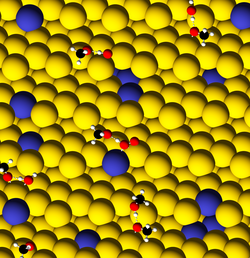Kontakt
Methanol Oxidation on Nanoporous Gold
Nanoporous metals, such as nanoporous gold (np-Au), have recently attracted considerable interest due to their potential use in catalysis. These Au-based catalysts can be used for electrocatalytic applications, in selective oxidation of olefins or alcohols, where the selectivity of gold to partial oxidation products is higher than the selectivity of other metal catalysts.
In this study, partial and full oxidation of methanol on np-Au is studied theoretically. The kinked and stepped Au(321) and Au(310) surfaces are used to model curved ligaments of nanoporous gold. Low coordinated atoms on steps and kinks are expected to be particularly favorable as adsorption positions of reactants and intermediates. The Au(321) surface was previously employed as model surface in an earlier study by Moskaleva et al. [1], where it was demonstrated that silver impurities inherently present in nanoporous gold can help activate molecular oxygen.
Pertinent catalytic surface reactions are analyzed using the exchange-correlation functional PBE [2] implemented in the plane-wave based Vienna ab initio simulation package (VASP) [3] within the supercell approach. The aim is the elucidation of the detailed mechanisms for total and partial oxidation of methanol on this model surface. We will calculate the adsorption geometries for the reaction intermediates and transition states in order to identify the energetically most favorable reaction paths.
Various active oxygen species on the gold surface, like atomic oxygen, molecular oxygen or hydroxo and hydroperoxo species on the reaction mechanisms will be considered.
[1] L.V. Moskaleva, V. Zielasek, T. Klüner, K.M. Neyman, M. Bäumer, Chem. Phys. Lett. 525 (2012) 87.
[2] J.P. Perdew, K. Burke, M. Ernzerhof, Phys. Rev. Lett. 77 (1996) 3865
[3] G. Kresse, J. Hafner, Phys. Rev. B 49 (1994) 14251.




